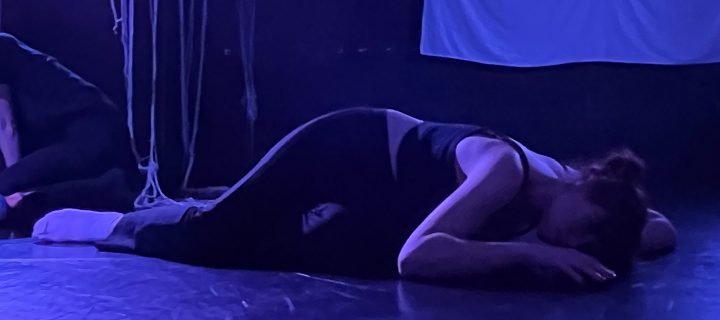We live in an apocalyptic age. The collapse of highly developed and precariously connected civilisation is a recurrent feature in human history; examples range from Bronze Age Middle East to Mesoamerica in the Classic Maya era. Today the disaster is global, and the unfolding climate catastrophe and newfound affection for nuclear weapons bring the terror of disintegration closer to home week by week. The blackbox larp End(less) Story (Norway 2022) by Nina Runa Essendrop taps into this mortal dread unapologetically and with compassion.

The writing room. Photo from The Smoke larp festival.
The participants (the larp is designed for 6–15 people) play the spirits of the last humans. The characters gradually remember fragments of their life and grapple with their foregone death, which also marks the end of humanity. The characters’ means of interacting with each other, always personal and ever ambiguous, first grow as their minds open up. They are then severed as the spirits approach either oblivion or the unknown beyond, the memory of our species erased or transformed with them.
The larp pointedly leaves the cause of extinction unspecified: climate catastrophe, war, asteroid impact or other terminal events are for the players to inject if they so choose. Short larps – End(less) Story is four hours long, including workshop and debrief – necessarily leave a lot of background to the players’ discretion, which can result in loss of coherence in the shared world and mutual narrative.

Photo from The Smoke larp festival.
End(less) Story sidesteps the problem by denying the players verbal communication. The larp is played in three rooms. In the first room, where the characters awake, the players can converse with each other by body expression, touch and movement. As lights turn on in the second room, the players can go there and interact by shadows cast on white fields with hands and sundry objects. The third room, which opens last, has a large sheet of paper with a single sentence written on it. The players can process the characters’ sensation by writing, but must incorporate a word already on the page, and cannot directly reply to or address each other. This elliptical linguistic intercourse makes for a creative contrast with the unmediated sensation of connecting by touch and movement.
Communication by touch is well adapted to the theme, as it steers the players to build a narrative on emotive currents rather than precise events. Absence of verbalisation also enables scenes that are significant for the story arc, but whose narrative meaning can radically differ from character to character, as the players individually frame their own story on the structure prepared by the organiser.
The rooms become dark and close off one by one, starting with the text area, and the spirits are forced back to their starting position. There they must relinquish their tenuous existence, whether or not they have been able to come to terms with their past history and immediate condition in this short time.

Interactions in the shadow play room. Photo from The Smoke larp festival.
The entire experience is supported by an informally ritualistic soundtrack of non-verbal Meredith Monk pieces. Three times her voice is punctuated by shots of loud brown noise, during which the characters recall their destruction with increasing clarity.
It’s a beautiful design, neatly implemented. After playing End(less) Story at the Grenselandet larp festival in Oslo in 2022, I was deeply moved and left with admiration for the composition. But reflection led to doubt.
Apocalypse and coming to terms with mortality are themes nearly as old as recorded fiction, featuring prominently already in the Epic of Gilgamesh. In the 1970s, post-apocalyptic fiction had particular resonance due to fear of nuclear devastation from runaway superpower competition. Climate anxiety of the 2000s is a more persistent variety of trauma, as now impending destruction is contingent on evident societal inaction, not on possible misaction by a handful of leaders.
This is reflected in works of art shifting their focus from life after the apocalypse to accepting the end of the world. For example, while the 2021 film Don’t Look Up may have been intended to coax people into action, its climax features the characters accepting their fate as they are annihilated together with the rest of humanity. In End(less) Story, the apocalypse is equally total, with no one left to pick up the pieces. This heightens the somewhat transcendental experience of the larp, but also raises questions.
Human extinction is inevitable. But collective conduct will determine whether it comes soon or waits in the far future. Art is made from the material of its day, and End(less) Story lives in the troubles of our era.
End(less) Story may be effective as desensitisation therapy for climate anxiety, helping either to resist paralysis in the face of insurmountable odds or to remain unperturbed in the face of extermination. Interpretation of larp is arguably more subjective than other narrative art forms, especially with a figurative work like End(less) Story. I felt End(less) Story to carry the message that even if you rage, the light will die, and wise people at their end know dark is right. Tranquillity in the face of personal deadly disease or lethal injury may be a philosophical virtue, but granting people the serenity to simply accept the things they could change is a different lesson altogether.
The question that hangs over End(less) Story is whether terminal illness is an apt metaphor for the present state of civilisation. As a counterpoint we may note that climate catastrophe is already here, it’s just not evenly distributed. Human existence is ending on a day-to-day basis, and we can make things worse or better.
The British politician Tony Benn famously said that progress is made because there are two flames burning in the human heart: the flame of anger against injustice and the flame of hope that you can build a better world. We should pause before reaching for the extinguisher.

The extinction room. Photo from The Smoke larp festival.
Bibliography
Don’t Look Up (2021), directed by Adam MacKay, Hyperobject Industries and Bluegrass Films.
Myths from Mesopotamia: Creation, Flood, Gilgamesh, and Others (1989). Oxford University Press.
Ludography
End(less) Story (2022): Norway. Nina Runa Essendrop.
This article has been reprinted with permission from the Solmukohta 2024 book. Please cite as:
Räsänen, Syksy. 2024. “Extinction Now: Coming to Terms with Dissolution in End(less) Story.” In Liminal Encounters: Evolving Discourse in Nordic and Nordic Inspired Larp, edited by Kaisa Kangas, Jonne Arjoranta, and Ruska Kevätkoski. Helsinki, Finland: Ropecon ry.
Cover photo: Photo from The Smoke larp festival. Image has been cropped.






